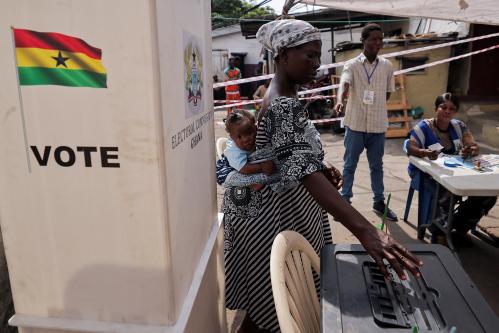Editor’s Note: The following op-ed, which was originally published in
The Indian Express
, is an adaptation of the chapter “India and the other BRICs: Energy and the implications for economic growth,” in the Economist Intelligence Unit report Empowering Growth: Perspectives on India’s Energy Future.
Economic aspirations in Brasilia, Moscow, New Delhi and Beijing are inextricably linked to the strength of their national energy sectors. As the economies of the BRIC nations continue to grow, their energy demand will rise sharply. According to data from the US government’s Energy Information Administration, by 2025 the BRICs, led by China, will account for nearly 38 per cent of global primary energy demand, up from 27 per cent in 2005. Some of its members will manage surging energy demand better than the others. Owing to their advantageous resource endowments and the nature of their energy consumption, Brazil and Russia are relatively energy-secure nations. In 2011, Russia and Brazil were the second and ninth largest producers of oil respectively. Last year, Russia was the world’s fifth-largest producer of coal and the world’s largest producer and exporter of natural gas. For its part, Brazil is almost entirely dependent on hydropower for electricity generation, and recent offshore oil discoveries may soon catapult it into the ranks of major oil exporters. China and India are less self-sufficient, but superior infrastructure and a centralised government position China better to meet its rising energy demand. India has the most unstable energy condition in the BRIC club, and possibly the most uncertain energy future of all.
The scale of the energy dilemma is not new, nor are the problems and the solutions. Indian policymakers were aware of the country’s crippling energy shortages decades before the mass blackouts that occurred this July. Policymakers know that power plants are starved of coal and natural gas, that subsidies promote waste and inefficient consumption and that electricity theft is rampant. Pricing reform and better enforcement of electricity theft are still two critical solutions.
To its credit, recent reforms announced by the government suggest that policymakers are refocused on modernising India’s energy policy. However, these same politicos have in the past implemented marginal reforms, while neglecting to implement transformative reforms that truly attract investment. Today, policymakers would be well served not to repeat such an error. The emerging global energy landscape and the new wave of consumers promise a sustained period of expensive energy.
The new global energy gluttons, a group that includes Indonesia, Malaysia, Saudi Arabia, Kuwait and the UAE, are still considered lynchpins of global supply, but are concurrently grappling with surging domestic demand. As a result, export volumes from these nations are in decline. For example, take Saudi Arabia, which accounted for one-fifth of India’s oil imports in 2011-12. Between 1991 and 2010, global demand for oil increased by 31 per cent, and Saudi Arabia’s production increased by more than one million barrels per day. During this same period (albeit with some fluctuations), however, exports from the kingdom remained flat at 6.6 million barrels per day. The natural gas market provides a similar picture: in the mid-1990s Indonesia and Malaysia accounted for roughly half of global LNG exports. Today, both countries are planning import facilities to meet growing demand. Kuwait and the UAE, both considered energy-rich nations, import LNG from as far away as Trinidad & Tobago to satisfy demand.
If nothing else, this trend should crystallise for Indian policymakers the urgency of major pricing reforms. In the short term, the oil price will reflect the prevailing macroeconomic and geopolitical winds at any given time. In the long term, however, most analysts forecast a consistent increase in the price of oil. Similarly, the long-term trend suggests that natural gas prices will remain high. Although GAIL is contracted to receive shipments of LNG from the United States at cheaper US prices, such a contract structure will be the exception, not the norm. Unlike Cheniere, GAIL’s American LNG supplier, most LNG producers are major oil and gas companies that need financing arrangements that justify investments in the exploration and production of natural gas, as well as the construction of multi-billion dollar gas liquefaction facilities. These financing realities suggest that oil-indexed contracts are likely to remain an integral component in global LNG trade. Although macroeconomic headwinds in China have depressed coal prices this year, pricing reform in Indonesia and surging demand in southeast Asia suggest that coal prices will also remain competitive in the future.
In this context, insufficient reforms will be costly. First, the surging cost of imported gas and coal, coupled with stagnant domestic production, have not only left power plants idle and bankrupted State Electricity Boards (SEBs), but they have also burdened the banking sector with a portfolio of non-performing loans. Government efforts to bailout SEBs without dramatic changes to electricity pricing will hinder any lingering incentives to invest in new generation, transmission and distribution projects and may raise the borrowing costs for any new investments. The new oil pricing reality is of greater concern. Reform will not dramatically change India’s import dependence on oil; even increased production will not make India self-sufficient. But now, amid ballooning fiscal deficits and jittery financial markets, market-determined prices are necessary to rid the government and the oil companies of unsustainable subsidies on their deficit-laden balance sheets.
Will such initiatives be too little, too late for India? Will its slowing growth and meandering energy and economic policies result in India becoming the first “fallen angel” among the BRIC nations, as Standard & Poor’s, a rating agency, warned in a June 2012 report? Perhaps not. Recent pro-reform messages from Delhi are promising. But unlike China, where the government can make unpalatable energy decisions relatively quickly, or Russia and Brazil, where they don’t need to because of the abundance of energy resources, India has a government that historically has been incapable of fully executing painful energy reforms. If India is to continue as a vibrant emerging market, it will have to tackle its energy-security weaknesses immediately. If it cannot, BRIC may lose an “I”.
The Brookings Institution is committed to quality, independence, and impact.
We are supported by a diverse array of funders. In line with our values and policies, each Brookings publication represents the sole views of its author(s).



Commentary
Op-edThe Energy-Poor BRIC
October 19, 2012